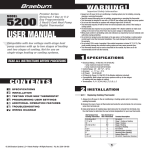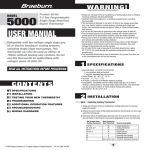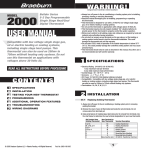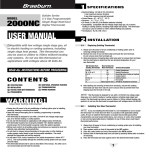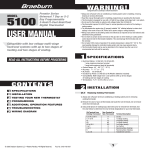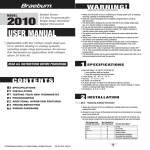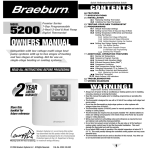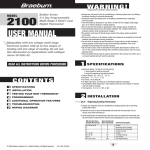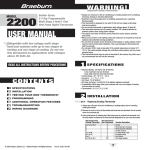Download Braeburn 5050 User manual
Transcript
WARNING! MODEL 5050 Premier Series Universal 7 Day or 5-2 Day Programmable Single Stage Heat/Cool Digital Thermostat USER MANUAL Compatible with low voltage single stage gas, oil or electric heating or cooling systems, including single stage heat pumps. This thermostat can also be used on 250mv to 750mv millivolt heating only systems. Do not use this thermostat on applications with voltages above 30 Volts AC. READ ALL INSTRUCTIONS BEFORE PROCEEDING CONTENTS 1 SPECIFICATIONS 2 INSTALLATION 3 TESTING YOUR NEW THERMOSTAT 4 5 6 7 PROGRAMMING ADDITIONAL OPERATION FEATURES TROUBLESHOOTING • Always turn off power to the air conditioning or heating system prior to installing, removing, cleaning or servicing thermostat. • Read manual thoroughly prior to installing, programming or operating thermostat. • This thermostat is designed for use with a 24 Volt-AC low voltage single stage gas, oil or electric heating or cooling systems, including single stage heat pumps. This thermostat can also be used on 250mv to 750mv millivolt heating only systems. • Do not use this thermostat on applications with voltages above 30 Volts AC. • This thermostat requires two (2) properly installed "AA" alkaline batteries to provide power for the thermostat to properly control the system operation. • Wiring must conform to all building codes and ordinances as required by local and national code authorities having jurisdiction. • Do not short (or jumper) across terminals on the gas valve or at the heating or cooling system control board to test the thermostat installation. This could damage the thermostat and void the warranty. • Do not select COOL mode of operation if the outside temperature is below 50˚ F (10˚ C). This could damage the controlled cooling system and cause personal injury. • This thermostat should only be used as described in this manual. Any other use is not recommended and will void the warranty. 1 SPECIFICATIONS • Electrical Rating: 24 Volt AC (18-30 Volt AC) 1 amp maximum load per terminal 2 amp total maximum load (all terminals) • Control Range: 45˚ - 90˚ F (7˚ - 32˚ C) • Accuracy: +/- 1˚ F (+/- .5˚ C) • DC Power: 3.0 Volt DC (2 "AA" Alkaline batteries included) • Compatibility: Compatible with low voltage single stage gas, oil or electric heating or cooling systems, including single stage heat pumps. This thermostat can also be used on 250mv to 750mv millivolt heating only systems. • Terminations: Rc, Rh, G, W, Y, B, O 2 INSTALLATION 2.1 Replacing Existing Thermostat 1. Always turn off power to the air conditioning or heating system prior to removing existing thermostat. 2. Remove the cover of your old thermostat and locate the wire terminals. Do not remove wires from terminals yet. 3. Using small pieces of masking tape, label wires prior to removal from terminals. Use the chart below to determine the new terminal designations for your new thermostat. WIRING DIAGRAMS © 2005 Braeburn Systems LLC • Patents Pending • All Rights Reserved. Important Safety Information Pub. No. 5050-100-006 Old Terminal from Existing Thermostat New Terminal for New Thermostat Terminal Description V or Rc M, 4, Rh, or R G or F H, W or 4 Y B O C Rc Rh G W Y B O None (Cap the wire) Cooling Transformer Heating Transformer Fan Control Heating Control Cooling Control Reversing Valve (Heating) Reversing Valve (Cooling) 24 Volt AC, Transformer Common 1 2 INSTALLATION 2.1 Replacing Existing Thermostat cont. cont. 4. After labeling and removing all wires from terminals, unscrew the existing thermostat sub-base from wall. Make sure to secure wires to prevent them from slipping back into the hole in the wall. NOTE: This thermostat is designed for use with 24-Volt AC low voltage single stage gas, oil or electric heating or cooling systems, including single stage heat pumps. This thermostat can also be used on 250mv to 750mv millivolt heating only systems. Do not use this thermostat on applications with voltages above 30 Volts AC. 2.2 Installing Your New Thermostat 2 INSTALLATION 2.2 Installing Your New Thermostat cont. 20. Using your finger, gently flip the switch towards the programing option which best suits your schedule. 21. Attach front body of thermostat to sub-base, being careful to align the terminal pins on the front body with the terminal block on the sub-base. 22. Open front thermostat door and open battery compartment door. 23. Install two new "AA" alkaline batteries into battery compartment. Make sure to locate the positive (+) ends of the batteries and match them with the positive (+) terminals located in the battery compartment. Close battery compartment. 24. Restore system power so you can test installation. NOTE: NOTE: 1. Always turn off power to the air conditioning or heating system prior to installing your new thermostat. 3 If you are installing this thermostat in a new installation be sure to locate the thermostat 4 to 5 feet above the floor in accordance with applicable building codes. Make sure to install the thermostat in a location that provides good airflow characteristics and avoid areas behind doors, near corners, air vents, direct sunlight or near any heat generating device. Installation in any of these areas could impact thermostat performance. 2. Place system switch on front of thermostat to OFF position. 3. Place fan control switch on front of thermostat to AUTO position. 4. Remove front of thermostat from sub-base by pressing release latch on bottom of thermostat. 5. Place the thermostat sub-base against wall in the desired thermostat location. 6. Guide thermostat wires through center hole in sub-base. Continue to hold against wall. 7. Mark placement of mounting holes as appropriate and drill using a 3/16" drill bit. Gently tap supplied plastic anchors into the holes in the wall. 8. Place the sub-base against the wall in the desired location, making sure the mounting holes are aligned and the thermostat wires are properly inserting through opening in sub-base. 9. Fasten the sub-base to wall using supplied screws. 10. Connect wires to quick wiring terminal block as appropriate using the new terminal designations. Refer to Wiring Diagrams section of this manual if required for assistance. 11. Make sure all of the wire connections are secure and are not touching any other terminal to prevent electrical shorts and potential damage to the thermostat. 12. Turn the front thermostat body over, exposing the rear view of the circuit board. 13. Locate the internal ˚F /C˚ switch on the circuit board. 14. Using your finger, gently flip the switch toward the preferred temperature ˚F / ˚C scale. 15. Locate the internal fan option switch, HG (Gas) / HE (Elec) on the circuit board. This switch controls the heating system fan delay. Select gas for gas or oil fired systems. This will allow the furnace to run for a few seconds before initiating the fan. Select electric for systems with electric furnace elements that require the fan to come on immediately. 16. Using your finger, gently flip the switch towards the HG (Gas) or HE (Elec) selection which indicates the low voltage heating system the thermostat will control. 17. Locate the internal NORM / HP switch on the circuit board. This switch configures the thermostat for normal (NORM) heating and cooling systems or heat pump (HP) systems. 18. Using your finger, gently flip the switch towards the NORM or HP selection which indicates the low voltage heating system the thermostat will control. 19. Locate the internal programming switch on the circuit board. This switch configures the programming mode, either 5-2 DAY (weekday-weekend), or full 7 DAY programming. 2 cont. If you installed the batteries prior to accomplishing steps 13 through 18, you will need to reset the thermostat to register your thermostat switch configurations prior to programming. Gently press the RESET button on the front of the thermostat using a paper clip or a small pencil tip. TESTING YOUR NEW THERMOSTAT WARNING! Read BEFORE Testing • Do not short (or jumper) across terminals on the gas valve or at the heating or cooling system control board to test the thermostat installation. This could damage the thermostat and void the warranty. • Do not select COOL mode of operation if the outside temperature is below 50˚ F (10˚ C). This could possibly damage the controlled cooling system and may cause personal injury. • This thermostat includes an automatic compressor protection feature to avoid potential damage to the cooling system from short cycling. This thermostat automatically provides a 5-minute delay after turning off the cooling system output to protect the compressor. This protection is also present in the heat mode of operation on single stage heat pump systems to protect the compressor. NOTE: Test your thermostat prior to programming any user settings. Pressing the RESET button will erase any user entries for time of day, day of week, option settings and programming if previously programmed. This will return all user settings to their default values. Remember, this will erase all programs entered by the user. 1. Place the system switch in the HEAT position. 2. Press the button on the keypad until the setpoint temperature setting is a minimum of 3 degrees higher than the current room temperature. The heating system should start within several seconds. The fan may not turn on immediately due to the heating system built-in fan delay. 3. Place the system switch in the OFF position. The heating system should stop within several seconds. On single stage heat pump systems you must wait 5 minutes for the automatic compressor short cycle protection period to expire, or press the RESET button to bypass this feature for initial testing purposes. Pressing the RESET button will erase any user entries for time of day, day of week, option settings and programming if previously programmed. 4. Place the system switch in the COOL position. 5. Press the button on the keypad until the setpoint temperature is a minimum of 3 degrees lower than the current room temperature. 6. The cooling system should start within several seconds. Place the system switch in the OFF position. 7. Place the fan switch in the ON position. The system blower should start. 8. Place the fan switch in the AUTO position. The system blower should stop. 3 4 PROGRAMMING 4 4.1 Default Thermostat Settings Setting the Temperature Differential Function Operation Mode Temperature Hold Clock Room Temperature Setpoint Temperature Temperature Scale Operating Program Low Battery Warning Temperature Differential Residual Cooling Fan Delay Short Cycle Protection Timer Output Relays Extended Hold Keypad Lock Adaptive Recovery Mode Filter Check Monitor Recirculating Fan Timer Status After Reset Normal Operating Mode Extended and Temporary Hold Cleared 12:00 pm, Monday 70˚ F (21.0˚ C), to be renewed within 5 seconds According to system switch: 62˚ F (17.0˚ C) for Heat or Off 83˚ F (28.0˚ C) for Cool ˚F or ˚C dependent on switch setting DAY program, Monday Off, to be renewed within 5 seconds 0.5˚ F (0.25˚ C) 60 seconds Reset Off Indefinite Unlocked Reset 0 Days OFF Reset with 120 minute off cycle 4.2 Setting Current Time of Day and Day of Week NOTE: It is important for you to set the current time of day (note AM/PM indicator in display), and the current day of week correctly to avoid problems with program execution. 1. When in normal operating mode, press the DAY/TIME keypad button. The LCD display will be cleared except for the time, am/pm indicator and the day of the week. The hour portion of the time will flash. 2. Press the or button to set the current hour. 3. Press DAY/TIME button again, the minute portion of the time will flash. 4. Press the or button to set the current minute. 5. Press DAY/TIME button again, the day of the week indicator will flash. 6. Press the or button to set the current day of the week. 7. Press DAY/TIME button again and the thermostat will return to normal operating mode. NOTE: The thermostat will return to normal operating mode automatically after 15 seconds if no key is pressed. It will also return to normal operating mode immediately if the RETURN button is pressed. 4.3 Setting Thermostat User Options The default user options are compatible with most systems and applications. They are normally set at the time of installation and usually do not require any modification under normal operating conditions. If you wish to change these settings, simply follow the instructions below. NOTE: The temperature differential settings are the same for both the heating and cooling systems. 4 PROGRAMMING cont. The default setting is 0.5˚ F (0.25˚ C). The room temperature must change 0.5˚ F (0.25˚ C) from the setpoint temperature before the thermostat will initiate the system in heating or cooling. 1. In normal operating mode, press and hold the RETURN button for 4 seconds. The LCD display will show "d1 X", where "X" equals the ˚F / ˚C differential setting. This is the current temperature differential setting. 2. Press the or button to set the temperature differential to your desired setting of 0.5˚, 1˚, or 2˚ F (0.25˚, 0.5˚, or 1˚ C). NOTE: Once you have finished setting the temperature differential you can wait 15 seconds and the thermostat will automatically return to the normal operation mode. Otherwise, you can press RETURN button again to set the Residual Cooling Fan Delay. Setting Residual Cooling Fan Delay The default setting is 60 seconds. During the COOL mode of operation, the fan will stay on for 60 seconds after the setpoint has been satisfied, and the compressor has turned off. 3. After pressing the RETURN button again, the display will show "FAN XX," where "XX" is the fan delay time in seconds. 4. Press the or button to change the Residual Cooling Fan Delay to the desired setting of 0 (disabled), 30, 60, or 90 seconds. 5. Press the RETURN button again to set the Extended Hold Time or wait 15 seconds to return to the normal mode. Setting the Extended Hold Time (see also section 5.3) The default setting is Long (indefinite) Hold. If the HOLD feature is activated, the current setpoint will be held until HOLD is released. 6. After pressing the RETURN button again, the display will show "HOLD LG", where LG is indefinite hold. HOLD 7. Press the or button to change the Extended Hold time from indefinite (LG) to 24 hours (SH). 8. Press the RETURN button again to set the Filter Check Monitor or wait 15 seconds for the thermostat to return to the normal mode. Setting the Filter Check Monitor (see also section 5.4) The default setting is 0 days (Filter Monitor disabled). 9. After pressing the RETURN button again, the display will show "FILT XXX SET", where XXX is the Filter Monitor interval (number of days since last warning). 10. Press the or button to change the Filter Monitor interval to the desired value of 0 (disabled), 30, 60, 90, 120, or 180 days. FILT 11. Press the RETURN button again to set the Recirculating Fan cycle, or wait 15 seconds for the thermostat to return to the normal mode. 5 4 PROGRAMMING cont. 4 PROGRAMMING cont. Setting the Recirculating Fan Cycle (see also section 5.7) Programming Overview for 7 Day Programming Mode cont. 12. After pressing the RETURN button again, the display will show "XXX OC SET", where XXX is the Recirculating Fan off cycle. Whole Week – allows you to program all seven days (M, TU, W, TH, F, SA, SU will show in display) at the same time. Then you can use individual day programming to fine tune your program for the few setpoint times or temperatures that you may wish to change. 13. Press the or button to change the Recirculating Fan off cycle to the desired value of 120, 60 or 40 minutes. Weekday – allows you to program all the weekdays (M, TU, W, TH, F will show in display) at the same time. Then go to Weekend group mode to finish programming your weekend setpoint times and temperatures. Individual day programming can be used to fine tune your settings to match your daily needs. 14. Press the RETURN button again to return to the normal mode, or wait 15 seconds for the thermostat to return automatically. 4.4 Setting Your Energy Saving Programs–Tips Before Starting Weekend – allows you to program the weekend days (SA, SU will show in the display) at the same time. Again, individual day programming can be used to change specific setpoint times or temperatures • It is important for you to set the current time of day (note the AM/PM in the display), and the current day of week correctly to avoid problems with program execution. This must be done prior to entering any programs. Individual Days – allows you to program each day of the week individually to give you the greatest schedule flexibility. Often used to fine tune programming after initially programming the thermostat using Whole Week, Weekday or Weekend groups. • The heating and cooling programs have both separate setpoint times and setpoint temperatures. IMPORTANT NOTE: When in group selection, the thermostat will check if all of the days of that group have the same program setpoint times and temperatures. If so, the time and temperature of the individual setpoint (MORN, DAY, EVE, NIGHT) will be displayed. • This thermostat is pre-programmed with weekday and weekend setpoint times and temperatures recommended by the Environmental Protection Agency and the U.S. Department of Energy in their ENERGY STAR® program. These settings provide efficient energy savings during normal heating and cooling modes of operation. If you wish to use the settings in the table, no further programming is necessary. Review these time and temperature settings prior to establishing your personal program settings to maximize your savings, and minimize programming requirements. Weekday Weekend MORN DAY EVE NIGHT Time: 6:00 am Heat: 70˚ F (21˚ C) Cool: 75˚ F (24˚ C) Time: 6:00 am Heat: 70˚ F (21˚ C) Cool: 75˚ F (24˚ C) Time: 8:00 am Heat: 62˚ F (17˚ C) Cool: 83˚ F (28˚ C) Time: 6:00 pm Heat: 70˚ F (21˚ C) Cool: 75˚ F (24˚ C) Time: 10:00 pm Heat: 62˚ F (17˚ C) Cool: 78˚ F (26˚ C) Time: 8:00 am Heat: 70˚ F (21˚ C) Cool: 75˚ F (24˚ C) Time: 6:00 pm Heat: 70˚ F (21˚ C) Cool: 75˚ F (24˚ C) Time: 10:00 pm Heat: 62˚ F (17˚ C) Cool: 78˚ F (26˚ C) • Make sure you place the system switch in the HEAT or COOL modes of operation as appropriate. You should not enter a program in the OFF position. • When the system switch is in the COOL or HEAT modes of operation, the appropriate indicator will appear in the LCD display when the system is running. When the system switch in the OFF mode, the display will indicate OFF. NOTE: If the 7 day programming mode was selected using the slide switch on the circuit board during installation (section 2.2), the default program will use the weekday times and temperatures shown above for all 7 days. The programming mode can be switched between weekday-weekend and 7 day at any time by removing the thermostat from the base, and following steps 19-21 in section 2.2, then pressing the reset button. All settings must then be reentered starting with section 4.2. Programming Overview for 7 Day Programming Mode (Programming switch set to 7 day—see installation section) You can select one of three Quick Program Groups or Individual Day programming to allow you to change the daily setpoint times and temperatures to meet your individual schedule needs. The Quick Program Groups can be used to set the main portion of your schedule, allowing you to later modify specific days of the week as required using the Individual Day programming capabilities. Otherwise, the individual setpoint time and temperature will be blanked. User is allowed to change the daily programs for this setpoint time and temperature by pressing the or button. This will reset all the daily programs of the group for that specific individual setpoint (MORN, DAY, EVE, NIGHT) time and temperature to the startup default for that setpoint. Continued pressing of the or button by the user will change setpoint time and temperature settings as desired. Entering Your Program 1. Place the system switch in the HEAT mode of operation. 2. Press the PROG button to enter Program setting mode. The MORN setpoint of the Whole Week Quick Program Group will be displayed. The display will show M, TU, W, TH, F, SA, SU, indicating the whole week is being programmed. The hour portion of the setpoint time and the AM/PM indicator will be flashing. 3. If you wish to use a different Quick Program Group or Individual Day program mode, you can change by pressing the DAY/TIME button to select another group in the following sequence, Whole Week - Weekday - Weekend - Monday - Tuesday Wednesday - Thursday - Friday - Saturday - Sunday - Whole Week. 4. Once you have finished your Quick Program Group or Individual Day selection, press the or button to change the time to the desired hour in one hour increments. Press the PROG button. The minute portion of the setpoint time will begin flashing. 5. Press the or button to change the time to the desired minute in 10-minute increments. Press PROG button. The SET TEMP will begin flashing. 6. Press the or button to change the setpoint temperature to the desired setting in 1˚ F increments (0.5˚ C). Press PROG button to save. The thermostat will now display the DAY setpoint time and temperature. Again, you will see the hour portion of the setpoint time and the AM/PM indicator will be flashing. 7. Follow steps 4 through 6 to set the set point times and temperatures for the MORN, DAY, EVE and NIGHT setpoints for the Quick Program Group or Individual Day selection for the HEAT mode. Once you enter program mode, you can select the Quick Program Group or Individual Day Programs as you desire. 6 7 5 ADDITIONAL OPERATION FEATURES Entering Your Program cont. 5.1 Review Set Temperature 8. Place the system switch in the COOL mode of operation. The display will show COOL. Follow steps 2 through 6 to program the setpoint times and temperatures for the Quick Program Group or Individual Day selection for the COOL mode. 1. Press and hold or button. The current setpoint temperature will be displayed in the place of the current room temperature, and the indicator SET TEMP will be displayed. 4 PROGRAMMING cont. 9. Follow steps 3 through 8 for additional Quick Program Groups or Individual Day programming as required. 10. After completion of programming, press RETURN or wait 15 seconds to return to the normal mode. NOTE: To erase all entered programs, current time of day, day of week and other user settings, gently press the RESET button using a paper clip or a small pencil tip. This will return all thermostat settings to their default values. Program Overview for Weekday/Weekend Programming Mode (Programming switch set to 5-2 day—see installation section) Your thermostat contains separate Weekday and Weekend Program Groups that allow you to change the daily setpoint times and temperatures to meet your individual schedule needs. Weekday – allows you to program all the weekdays (M,TU, W, TH, F will show in display) at the same time. Allows programming times and temperature settings for four setpoints (MORN, DAY, EVE, and NIGHT) to meet your daily weekday schedule needs. Weekend- allows you to program all the weekend days (SA, Su will show in the display) at the same time. Again allows programming times and temperature settings for four setpoints (MORN, DAY, EVE, and NIGHT) to meet your daily weekend schedule needs. Entering Your Program 1. Place the system switch in the HEAT mode of operation. 2. Press the PROG button to enter Program setting mode. The MORN setpoint of the Weekday Program Group will be displayed. The display will show M, TU, W, TH, F, indicating the Weekday group is being programmed. The hour portion of the setpoint time and the AM/PM indicator will be flashing. 2. The display will return to normal operating mode when the or button are released. Continuing to hold the or button for 3 seconds or longer will allow the user to temporarily override the current programmed setpoint (See Temporary Program Override). 5.2 Temporary Program Override 1. Press and hold or button for 3 seconds. The entire display will flash once and the SET TEMP indicator will be displayed. Release the or button and press the or button again as desired to adjust the set temperature. 2. The display will return to normal operating mode after 15 seconds or you can press the RETURN button. 3. The program indicator (MORN, DAY, EVE or NIGHT) will be flashing in the display, indicating that a Temporary Program Override is in effect. The Temporary Program Override will reset when the next setpoint time occurs, or after 4 hours - whichever comes first. 5.3 Extended Hold (Vacation) Mode 1. Press the HOLD button to bypass the program schedule. The current setpoint temperature will be held either permanently or for 24 hours depending on the setting selection made in section 4.3. 2. Press the HOLD button again to return the thermostat to normal program operation. 3. The hold period lasts until the hold is released as in step number 2 above, or is limited to 24 hours if the default was changed in the User Options Settings (section 4.3) 3. Press the or button to change the time to the desired hour in one hour increments. Press the PROG button to save. The minute portion of the setpoint time will begin flashing. 5.4 Filter Check Monitor (see section 4.3 for setting) 4. Press the or button to change the time to the desired minute in 10-minute increments. Press the PROG button to save. The SET TEMP will begin flashing. The Filter Check Monitor displays a reminder for required filter replacement or cleaning, by flashing the FILT segment in the display. See instructions on your filter or heating/cooling unit for recommendations for interval setting. 5. Press the or button to change the setpoint temperature to the desired setting in 1˚ F increments (0.5˚ C). Press the PROG button to save. The thermostat will now display the DAY setpoint time and temperature. Again, you will see the hour portion of the setpoint time and the AM/PM indicator will be flashing. 6. Follow steps 3 through 5 to set the setpoint times and temperatures for the MORN, DAY, EVE and NIGHT setpoints for the Weekday group in the HEAT mode. 7. After pressing the PROG button, you will enter the Weekend Program Group. The display will show SA, SU to indicate the Weekend group is being programmed. The hour portion of the MORN setpoint time and the AM/PM indicator will be flashing. 8. Follow steps 3 through 5 to set the setpoint times and temperatures for the MORN, DAY, EVE and NIGHT setpoints for the Weekend group in the HEAT mode. 9. Place the system switch in the COOL mode of operation. The display will show COOL. Follow steps 2 through 8 to program the setpoint times and temperatures for the Weekday and Weekend groups in the COOL mode. NOTE: To erase all entered programs, current time of day, day of week and other user settings, gently press the RESET button using a paper clip or a small pencil tip. This will return all thermostat settings to their default values. 8 When the selected interval has been reached, and required cleaning or replacement has been performed, press the RETURN button in any normal mode to reset the timer and turn off the warning. 5.5 Locking the Keypad To prevent accidental or undesired adjustment of the thermostat, the Keypad Lockout feature disables the operation of the keypad except for the backlight key. In order to lock the keypad, press and hold both the and buttons together at the same time for 5 seconds. The LOCK segment in the display will flash once per second, and then appear continuously in the display. The keypad is now locked. To unlock the keypad, press and hold the and buttons together at the same time for 1 second. The LOCK segment will disappear and the keypad will become unlocked. 9 5 ADDITIONAL OPERATION FEATURES cont. 5.6 Adaptive Recovery Mode (ARM™) In order to maximize comfort and energy efficiency, this thermostat is equipped with an Adaptive Recovery Mode (ARM™). This feature minimizes the amount of time required by the heating or cooling system to reach the new setpoint, after a setback period is completed, and assures your desired temperature is achieved at your set program times. This feature activates when recovering room temperature from setback programs to comfort programs, so it will only take place when the current (heating) program setpoint temperature is lower than the upcoming program setpoint temperature, or the current (cooling) program setpoint temperature is higher than the upcoming program setpoint temperature. During ARM™, room temperature is recovered gradually by turning on the heating or cooling before the end of the set back period. The setpoint temperature is changed to that of the upcoming comfort program temperature. The start time of recovery is based on the difference between the current room temperature and the upcoming comfort program setpoint temperature. The recovery to the upcoming setpoint starts 10 minutes before the upcoming setpoint time for each degree of temperature change required, up to a maximum of 2 hours. ARM™ does not operate when the unit is in the HOLD mode, or if the program is temporarily overridden. 5.7 Recirculating Fan Mode (see section 4.3) The Recirculating Fan Mode provides more even temperature distribution and improves indoor air quality by circulating air through the furnace filtration system more often. The Recirculating Fan Mode can be selected by moving the fan switch to the recirculate position( ®). If no call for heating or cooling occurs within the fan off cycle set in section 4.3, the fan will run for 12 minutes. The highest setting, 120 minutes (factory default), will run the fan least often–9% minimum run time. The lowest setting, 40 minutes, will run the fan most often–23% minimum run time. During any call for heating or cooling, fan control returns to the AUTO mode. The Recirculating Fan feature is available in the HEAT, OFF, or COOL mode. 5 5.9 ADDITIONAL OPERATION FEATURES cont. Compressor Protection This thermostat includes an automatic compressor protection feature to avoid potential damage to the cooling system from short cycling. This thermostat automatically provides a 5-minute delay after turning off the cooling system output to protect the compressor. This protection is also present in the heat mode of operation on single stage heat pump systems to protect the compressor. NOTE: The installer can reset the thermostat and bypass the compressor protection features by pressing the RESET button. This will erase all entered programs, current time of day, day of week and other user settings and should only be used during installation for testing purposes or to reset a thermostat to regain normal operation. This will return all thermostat settings to their default values. NOTE: Resetting the thermostat by pressing the RESET button will erase all entered programs, current time of day, day of week and other user settings. This will return all thermostat settings to their default values. Changing ˚F / ˚C temperature scale default should be done prior to installation and before any programming to avoid loss during reset step. 5.10 Low Battery Detection and Replacement This thermostat requires two (2) properly installed "AA" alkaline batteries to provide power for the thermostat to properly control the system operation. This thermostat is equipped with a low battery detection feature that constantly monitors the batteries during normal operating mode to determine whether they have sufficient power to provide proper operation. When this feature determines that the battery status is low, a low battery indicator will appear in the display. It is recommended that the batteries be replaced immediately to maintain system operation and program settings. Replacing the Batteries 5.8 Low Temperature "Freeze" Protection 1. Open the front thermostat cover and locate the battery compartment door. While the thermostat is in the HEAT mode of operation, on standard heating (non-heat pump) applications, the thermostat will mechanically initiate a call for heat if the room temperature drops to less than 41˚F (5˚ C). The system selector switch must be in the HEAT position for this feature to be active. This feature will allow the thermostat to initiate a call for heat on standard heating (non-heat pump) applications, to provide a minimum amount of heat, even if the batteries are dead or missing. This feature is only active on standard heating (non-heat pump) applications and is not available on single stage heat pump applications. 2. Gently remove the two "AA" alkaline batteries located in the battery compartment. 3. Install two new "AA" alkaline batteries into battery compartment. Make sure to match the positive (+) ends of the batteries with the positive (+) terminals located in the battery compartment. 4. Close battery compartment and verify that the low battery indicator does not appear in the display. 5.11 Resetting the Thermostat The Reset feature allows the user to completely reset the thermostat to register new manual switch settings. To erase all entered programs, current time of day, day of week and other user settings, gently press the RESET button using a paper clip or a small pencil tip. This will return all thermostat settings to their default values and register all new manual switch settings for proper operation. 10 11 6 TROUBLESHOOTING 6 TROUBLESHOOTING cont. SYMPTOM POTENTIAL SOLUTION SYMPTOM POTENTIAL SOLUTION Thermostat does not turn on heating or cooling system. Check to see if OFF is shown in display. This indicates that the system is turned off at the thermostat. Move the system selector switch to the HEAT or COOL position. After the compressor short cycle protection 5-minute period expires the system should start within a minutes time. Low battery indicator is shown in thermostat display. Replace batteries immediately to maintain proper system operation. See Low Battery Detection and Replacement section of this manual. Compressor protection feature may be in effect due to compressor short cycle conditions, power outages or rolling blackouts. See Compressor Protection section for full explanation of this feature. OFF is shown in thermostat display and heating or cooling system will not start. This indicates that the system is turned off at the thermostat. The thermostat must be in HEAT or COOL modes of operation to control the heating or cooling system. Move the system selector switch to the HEAT or COOL position. Thermostat display is blank. It is possible that the batteries are drained and not providing power for the thermostat to control the system. Replace batteries immediately to maintain proper system operation. See Low Battery Detection and Replacement section of this manual. If you replace the batteries and the display does not appear, call a professional service technician to verify thermostat and system performance. HI is shown in the thermostat display where the room temperature is normally displayed. The temperature sensed by the thermostat is higher than the 90˚ F (32˚ C) upper limit of the thermostats display range. The display will return to normal after the sensed temperature lowers within the 45˚ to 90˚ F (7˚ to 32˚ C) display range. Turn on the cooling system or use other methods to lower the temperature accordingly. Heating or cooling system may be malfunctioning. Call a professional service technician immediately to verify system operation. Thermostat turns on heating instead of cooling or cooling instead of heating. Check thermostat wiring to make sure that the heating and cooling stages are connected to the correct terminals on the wiring terminal block. See Installation and Wiring Diagrams sections of this manual. Thermostat will not follow program setpoints. Check current time of day, day of week program settings. Make sure to verify AM/PM indicator is accurately displaying desired time settings. See Setting Current Time of Day and Day of Week section of this manual. Check to see if OFF is shown in display. This indicates that the system is turned off at the thermostat. Move the system selector switch to the HEAT or COOL position. After the compressor short cycle protection 5-minute period expires the system should start within several seconds. Verify your program setpoint time entries. The heating and cooling programs utilize the same setpoint times, but have individual set point temperatures for the MORN, DAY, EVE and NIGHT setpoints. See Setting Your Energy Saving Program section of this manual. This condition could occur from the system being turned off during an exceptionally warm period or upon installation when the thermostat has been stored for a long period of time in a warm vehicle or location prior to being installed. The thermostat is equipped with a mechanical high temperature safety switch that will turn off the thermostat should the temperature exceed 99˚ F (37˚ C). Thermostat program has been temporarily overridden and program indicator is flashing in the display. Press RETURN button to return the thermostat to normal program operation or wait until next setpoint and the temporary override will expire. Thermostat program is in Extended Hold (Vacation) Mode and HOLD and TEMP is showing in display. Press HOLD or RETURN button to release permanent hold and return the thermostat to normal program operation. Thermostat turns heating or cooling system on too often or not often enough. Increase or decrease first stage temperature differential setting as appropriate to provide the desired performance level. See Setting Temperature Differential section of this manual. LO is shown in the thermostat display where the room temperature is normally displayed. The temperature sensed by the thermostat is lower than the 45˚ F (7˚ C) lower limit of the thermostats display range. The display will return to normal after the sensed temperature rises within the 45˚ to 90˚ F (7˚ to 32˚ C) display range. If the temperature in the controlled space seems to be normal, wait for the thermostat to acclimate to the correct room temperature. If the room seems to be colder than usual, turn on the heating system to raise the temperature as needed for comfort within the room. This condition could occur from the system being turned off during a cold weather period or upon installation when the thermostat has been stored for a long period of time in a cold vehicle or location prior to being installed. The thermostat should be allowed to warm up prior to installation to allow proper heating control once installed. 12 13 6 TROUBLESHOOTING cont. SYMPTOM POTENTIAL SOLUTION Thermostat will not allow me to program a setpoint temperature higher than 90˚ F (32˚ C). This is above the normal thermostat temperature setting range of 45˚ to 90˚ F (7˚ to 32˚ C). Thermostat will not allow me to program a setpoint temperature lower than 45˚ F (7˚ C). This is below the normal thermostat temperature setting range of 45˚ to 90˚ F (7˚ to 32˚ C). Thermostat will not allow me to change the setpoint. The Keypad is locked. Press both the and key together at the same time for one second to unlock (See section 5.5). Fan continues to run all the time whether the system is on or off. Check that the fan control switch is in the AUTO position. This will allow the fan to run only when the heating or cooling system is turned on and running. Fan Runs intermittently or when system is OFF. 7 WIRING DIAGRAMS Typical 4-Wire Single Transformer Heating and Cooling System Rc Rh G W Y B O Factory Installed Jumper Heat Control Fan Control Cool Control 24 Volt AC Transformer Hot Side Transformer Check thermostat wiring to make sure that the fan control wiring is connected to the correct terminals on the wiring terminal block. See Installation and Wiring Diagrams sections of this manual. Fan switch is in Recirculate ( ®) Mode. The room is too warm or too cold. See Review Set Temperature section of this manual to verify the current setpoint and make any modifications that are necessary. The thermostat does not allow me to program each day separately. Change from Weekday-Weekend to 7 Day Mode (see section 4.4). System turns on prior to the end of a setback period. Thermostat is in Adaptive Recovery Mode- (see section 5.6). 14 NOTES: 120 Volt AC 1. For Heating or Cooling Only System, ignore opposite connection. 2. For 2-Wire 24 Volt AC or 250mv - 750mv Millivolt Heating Systems, ignore cooling connection and fan control. Typical 5-Wire Two Transformer Heating and Cooling System Rc Rh G Remove Factory Installed Jumper Hot Side Cool Transformer W Y B O Heat Control Hot Side Heat Transformer Fan Control Cool Control Heat 24 VAC Transformer Cool 24 VAC Transformer 120 Volt AC 120 Volt AC 15 7 WIRING DIAGRAMS cont. Typical Single Stage Heat Pump System Rc Rh G W Y B O Factory Installed Jumper Compressor Control Fan Control Hot Side Transformer NOTE: Reversing Valve 24 Volt AC Transformer 120 Volt AC Store this booklet for future reference For reversing valve active in heating, use B terminal instead of O terminal. Braeburn Systems LLC, as an Energy Star partner has determined that this product meets the Energy Star Guidelines developed by the U.S. Environmental Protection Agency & the U.S. Department of Energy for maximum energy efficiency. For more information on energy savings, go to www.energystar.gov Braeburn Systems LLC warrants each new Braeburn thermostat against any defects that are due to faulty material or workmanship for a period of five years after the original date of purchase by a professional service technician. This warranty and our liability does not apply to batteries, nor does it include damage to merchandise or the thermostat resulting from accident, alteration, neglect, misuse, improper installation or any other failure to follow Braeburn installation and operating instructions. Braeburn Systems LLC agrees to repair or replace at its option any Braeburn thermostat under warranty provided it is returned postage prepaid to our warranty facility in a padded carton within the warranty period, with proof of the original date of purchase and a brief description of the malfunction. This limited warranty does not include the cost of removal or re-installation. This warranty gives you specific legal rights and you may also have other rights that vary from state to state or province to province. Answers to any questions regarding our limited warranty may be obtained by writing our corporate offices. WARRANTY FACILITY: Braeburn Systems LLC Attn: Warranty Department 2215 Cornell Avenue Montgomery, IL 60538 16 Braeburn Systems LLC 2215 Cornell Avenue • Montgomery, IL 60538 Technical Assistance: www.braeburnonline.com Call us toll-free: 866-268-5599 (U.S. Only) 630-844-1968 (Outside the U.S.) © 2005 Braeburn Systems LLC • Patents Pending • All Rights Reserved. Pub. No. 5050-100-006









